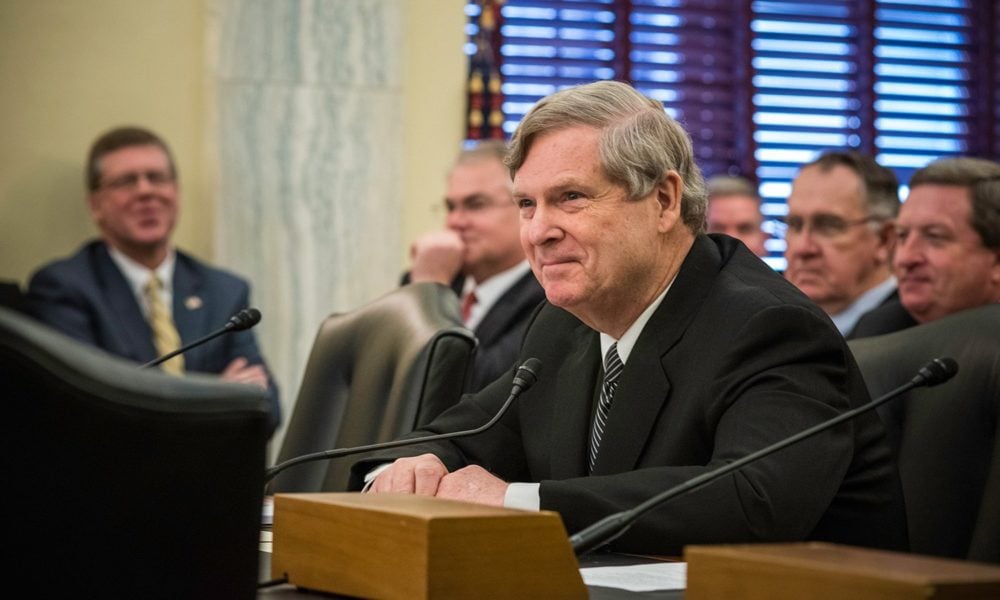The last time the US Department of Agriculture (USDA) got a new leader, I was decidedly unimpressed. Okay, understatement…I was incensed by a secretary who cared little for science and was fully in the pocket of big agribusinesses (looking at you, Dow). After four years of all that, it’s refreshing to see a new administration listening to scientists and pledging to address the multiple crises we face. At the same time, the hill facing us is steep, and bold actions are needed.
Today, former Iowa governor Tom Vilsack will appear before the Senate Agriculture Committee in a reprise of his 2009 confirmation process to lead the USDA. A political moderate, Vilsack is respected and even liked by members of the committee from both parties. It’s likely he will be confirmed easily. Still, his nomination hasn’t been universally welcomed, and he will need to prove that he’s up to the task in a world that in some ways looks quite different than it did 12 years ago, but also presents some of the same old, unaddressed problems.
Here are some questions I hope members of the Senate committee will ask him:
This time, will there really be a “new era of civil rights” at the USDA?
Whistleblowers have long complained that the USDA has a culture of racial and gender discrimination and harassment. And under Obama/Vilsack, Black farmers continued to face systemic racism in the department. They haven’t forgotten, expressing deep disappointment with President Biden’s nomination of Vilsack after the secretary failed to deliver on his promise the first time around.
But the new administration has pledged to right those old wrongs. As a show of good faith, President Biden has begun putting in place a team at the USDA, including new advisors on COVID-19 and nutrition, that looks more like the nation. And his deputy secretary selection would break a new glass ceiling at the USDA—assuming they are both confirmed, Vilsack will be backed up by Jewel Bronaugh, a Black woman who currently serves as the state of Virginia’s commissioner of agriculture.
Of course, diversifying the leadership of the USDA is an excellent start, but it will take persistent commitment to make real change. Senators should ask Vilsack:
- What further steps will he take to change the USDA’s culture to one of inclusion and equity?
- What, specifically, will do to level the playing field for Black, Indigenous, and People of Color (BIPOC) farmers and ensure that they and their communities are provided equitable support from USDA programs and staff? (We have some recommendations for that.)
Will Vilsack’s USDA stand with workers and farmers, or with Big Ag?
The previous administration largely left the most vulnerable workers in our food system subject to the whims of their employers (including multinational conglomerates like Tyson Foods) throughout the pandemic. As a result, thousands of frontline food processing and farm workers have contracted the virus and hundreds have died. UCS recently estimated that another 45,500 to 61,000 more such workers will contract COVID-19 in the months ahead, resulting in 200 additional tragic and unnecessary deaths.
In his first days in office, President Biden took an encouraging first step to better protecting food workers, directing the Occupational Safety and Health Administration to revise guidance to employers on workplace safety within two weeks and focus enforcement on the worst violations. And his USDA nixed the previous administration’s proposed rule to further deregulate poultry processing plants in ways that would have made those jobs even more dangerous. But there is much, much more to do to protect essential food system workers.
Moreover, the same big corporations and highly consolidated industries also exert too much power over farmers, reducing competition and holding down the prices farmers get for their products. Only by breaking the near-monopoly power of giant companies throughout the food and farming system can the Biden administration offer real opportunity for farmers and build back rural communities that have been decimated by decades of commodification and consolidation.
Senators should ask:
- What next steps does Vilsack intend to take to better protect food and farmworkers from COVID-19? How will his USDA quickly use funding recently authorized by Congress for protection of food and farm workers?
- And what will he do to ensure food and farmworkers are better protected and paid going forward, even beyond the pandemic?
- How will Vilsack’s USDA act to address and resolve damaging consolidation and concentration in agriculture?
Will Vilsack fully embrace soil as a critical tool to fight climate change?
The science is clear: various authoritative reports, most notably the multi-agency 2018 Fourth National Climate Assessment, have reviewed what science is telling US farmers to expect in coming decades—and it is not pretty. Changing precipitation and temperature patterns will lead to increases in floods and droughts, which in turn will yield to changes in crop and livestock viability and new pests. Yet, if the millions of acres of agricultural land in this country were managed in a way that actively promoted soil health, farmers would be better equipped for the future, as would future generations.
To test Vilsack’s commitment, Senators should ask:
- Will he expand the USDA’s network of Climate Hubs, established under his watch in 2014, to better serve farmers and farm communities who need to make informed decisions on the front lines of the climate crisis?
- And will he put more—much more—of the USDA’s might behind building back the health of the nation’s badly degraded and depleted farm soils?
How will Vilsack improve the nation’s nutrition?
The USDA has many opportunities to combat hunger and food insecurity and improve nutrition for vulnerable populations, including children. Secretary Vilsack helped advance nutrition and hunger policy during the Obama administration—putting in place new rules that made school food healthier, for example. But his successor attempted to dismantle nutrition policy, rolling back key school lunch standards and seeking to prevent underemployed workers, immigrant families, and other from receiving federal assistance to put food on the table.
Meanwhile, hunger continues to reach record levels in the United States as a result of the COVID-19 pandemic. Food insecurity was estimated to impact more than 50 million people in 2020, including 17 million children.
The new administration has already taken critical steps to expand and increase the Supplemental Nutrition Assistance Program (SNAP) and associated pandemic-related programs, but we know the effects of hunger may last long after COVID crisis itself ends. Senators should ask:
- How will the USDA use data and research to ensure that nutrition assistance programs meet the needs of US households even after the immediate threat of the pandemic has passed?
- What actions will the USDA take to provide needed assistance and information to immigrant families who may have been deterred from participating in SNAP?
How will Vilsack rebuild science and restore scientific integrity at the USDA?
To put it bluntly, the previous administration took a sledgehammer to science. Hundreds of scientists have left agencies such as the Environmental Protection Agency and the Fish and Wildlife Service since 2017, according to a new UCS analysis. At the USDA, a haphazard and politically motivated relocation of the Economic Research Service and the National Institute of Food and Agriculture from Washington, DC to Kansas City resulted in a staggering 75 percent of staff leaving both agencies. The scientific mission of the USDA has been gutted. Senators should ask:
- What is Vilsack’s plan for not just filling the tremendous void of hundreds of vacant positions, but truly rebuilding the department’s scientific agencies, repairing morale, strengthening scientific integrity, and revitalizing the department’s capacity to conduct independent science for the public good? (See our recommendations.)
- How does he intend to create a workforce that is diverse, expert, and uncompromised by industry influence?
We’ll be watching
My colleagues and I are cautiously optimistic about the direction President Biden and Secretary designate Vilsack seem to want to take the USDA. It surely won’t be everything we’d hope for. Still, we can see a roadmap for progress. We’ll be watching and listening for more details in Vilsack’s Senate hearing and beyond, and if he is confirmed, urging him to get on with it. There is no time to lose.

